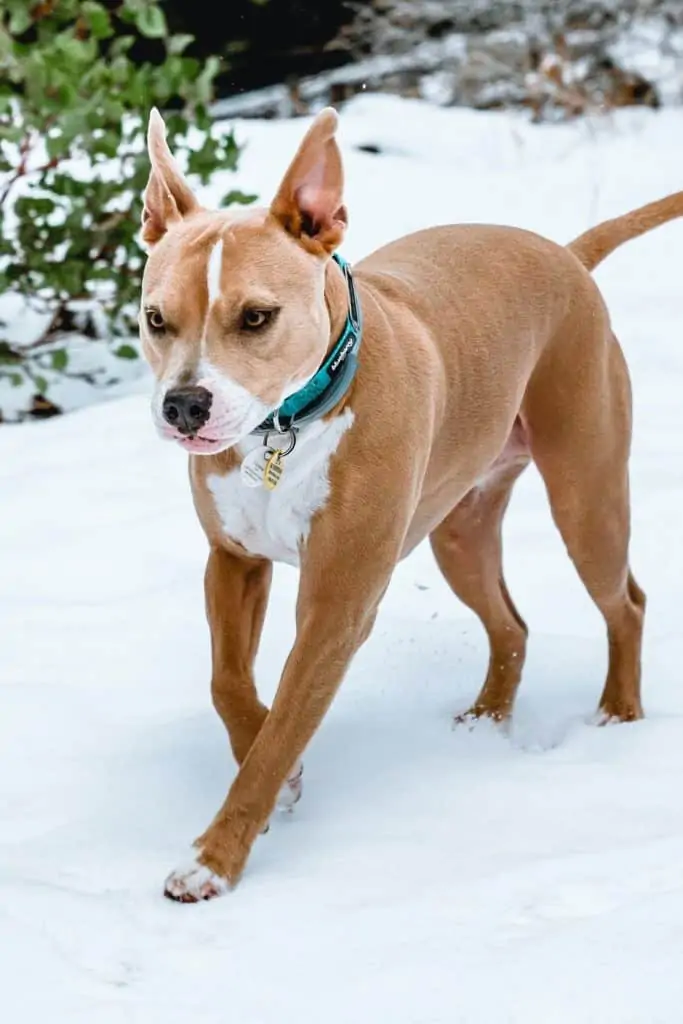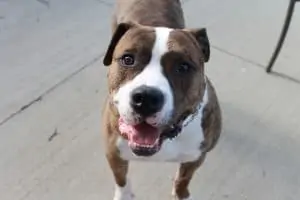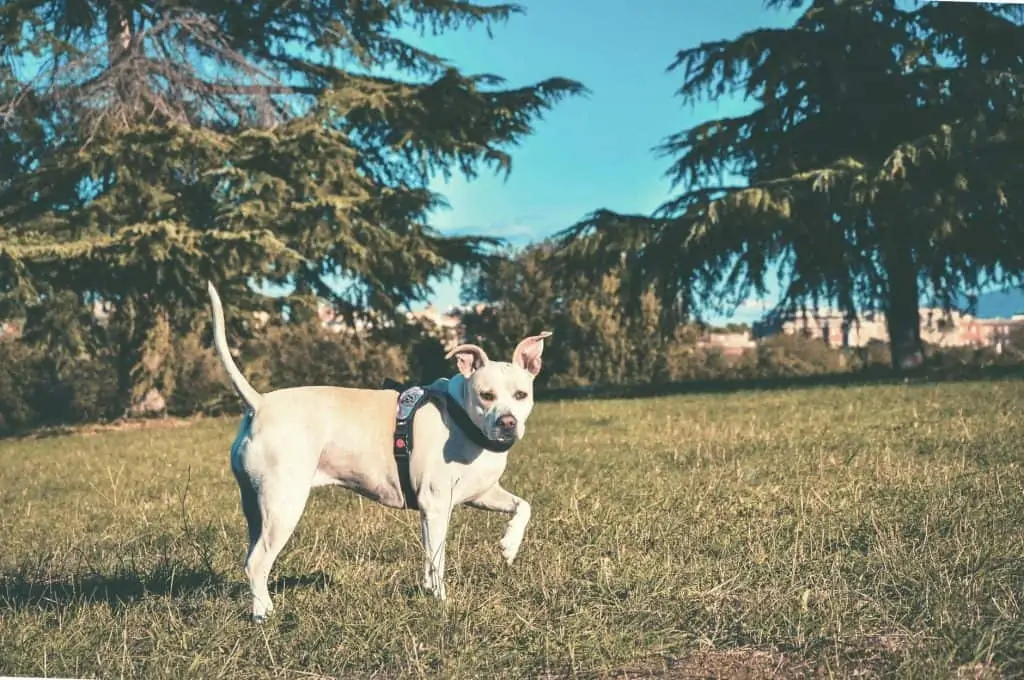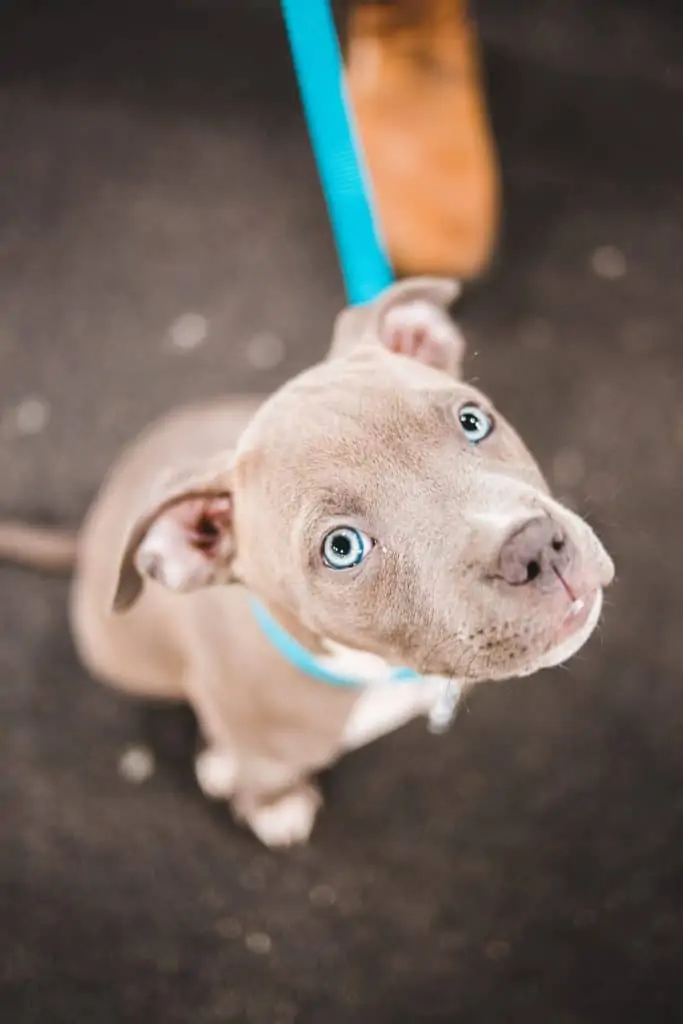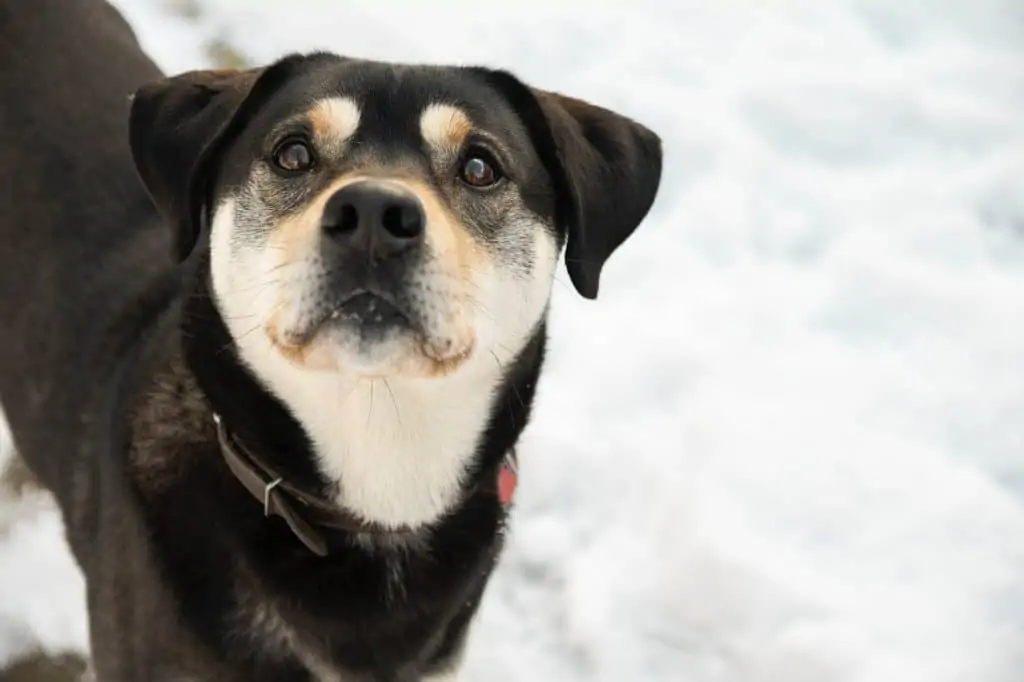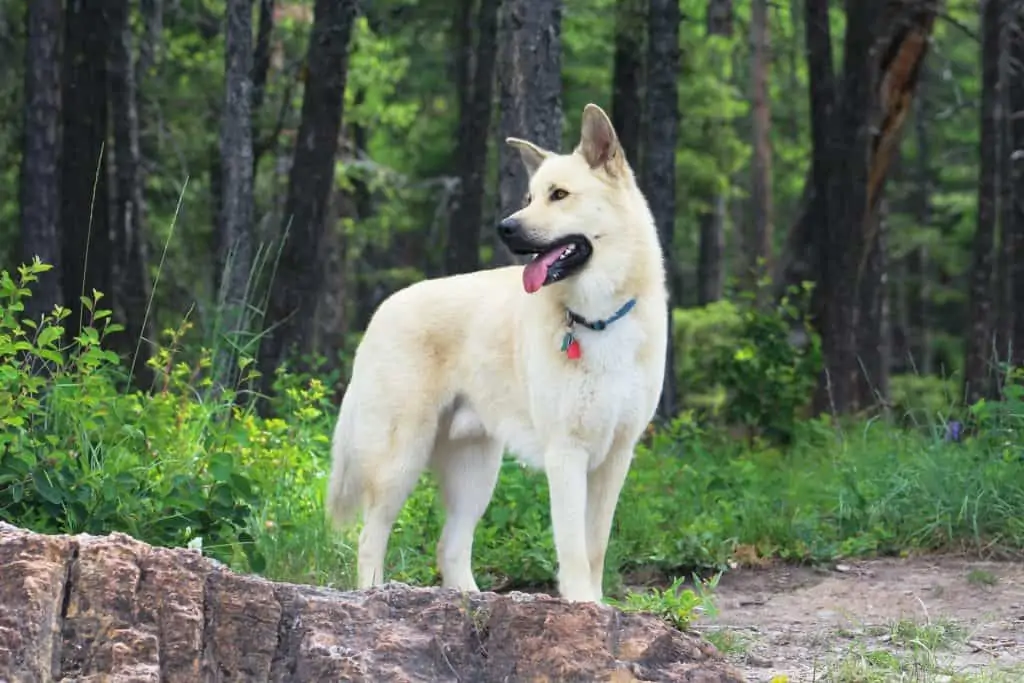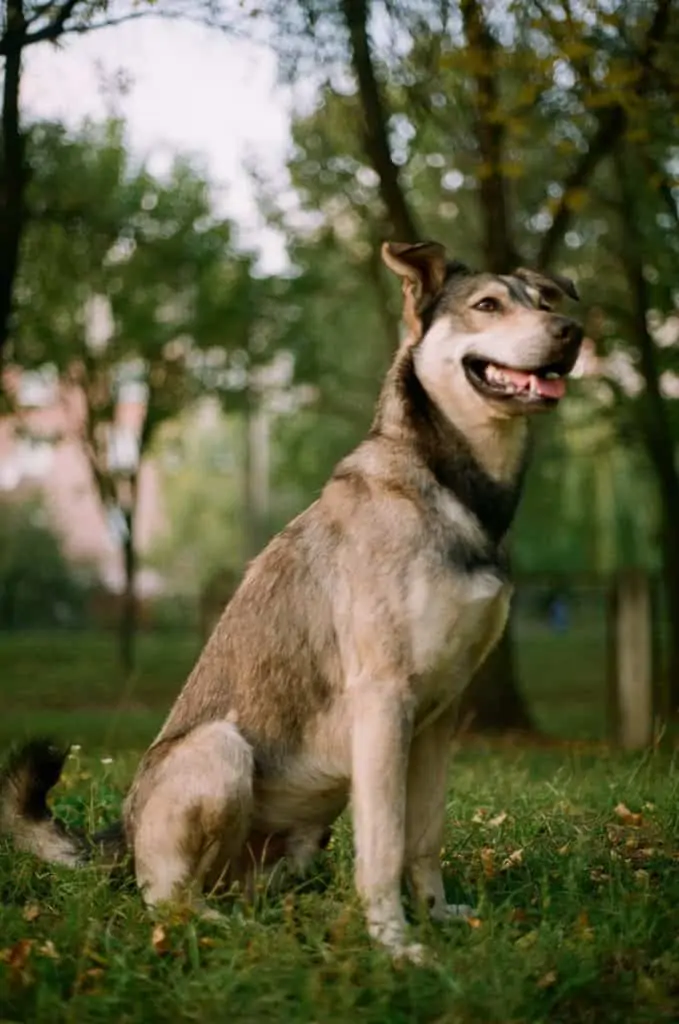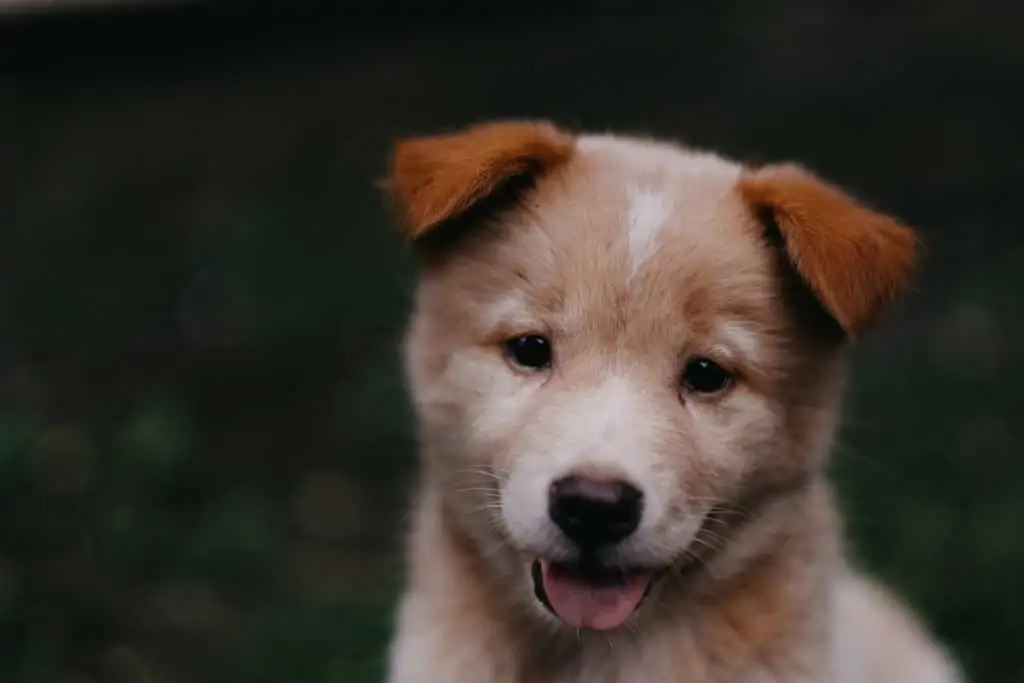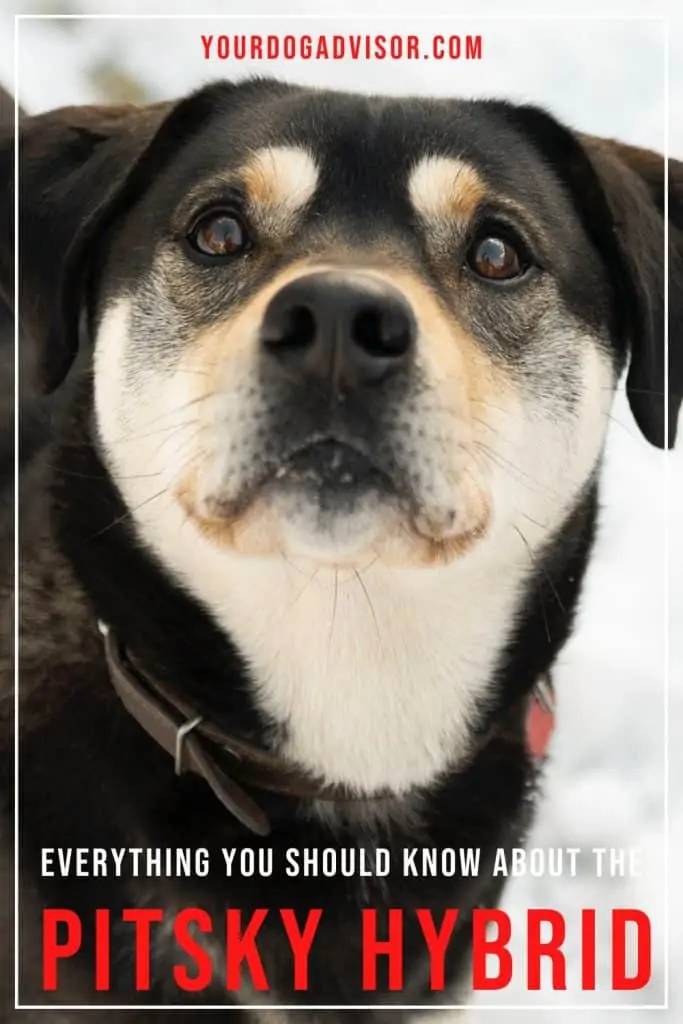Beautiful, energetic, devoted and family oriented – these are all words that effortlessly describe the adorable Pitsky hybrid.
This designer dog, also known as a mixed breed or crossbreed, has been rising in popularity over the last two decades. However, Pitsky dogs can also be overwhelming for the novice dog owner and require quite a bit of care, love and commitment.
Do you have what it takes to raise a Pitsky dog? Let’s find out!
Contents
Meet The Pitsky – The Pitbull Husky Mix
A Pitsky is a cross between a Pitbull and a Husky.
Other Names: The Huskybull, The Husky Pit, The Pitbull x Husky Mix, The Siberian Pitsky
Parent Breeds: The Siberian Husky and the American Pitbull Terrier
Average Height: 16 to 25 Inches
Average Weight: 30 to 80 Pounds
Temperament: Devoted, Energetic, Playful, Affectionate, Protective, Stubborn
Best Suited For: Experienced dog owners, active families, active owners, committed dog owners
Health Issues: Hip Dysplasia, Elbow Dysplasia, Skin Issues, Allergies, Thyroid Problems, Congenital Heart Defects, Degenerative Myelopathy, Kneecap Dislocation, Gastric Dilation-Volvulus (AKA Bloat or GDV), Cataracts, Progressive Retinal Atrophy, Follicular Dysplasia, Zinc Deficiency, Hypothyroidism, Corneal Dystrophy, Uveodermatologic Syndrome
Lifespan: 12 to 15 Years
Crossbreed Overview:
The Pitsky hybrid is a medium sized dog with a short, shedding coat, muscular body and energetic personality.
This is a mixed breed that is becoming more and more popular by the year, but he’s still a relatively new dog to the crossbreed kingdom. In fact, Pitsky’s have only recently cropped up over the last seven or eight years.
Of course, crossbreeding dogs has been going on for much longer, with other famous designer dogs like Poodle mixes and toy breeds starting the trend off strong.
The Pitsky in particular is the crossbreed offspring of the American Pitbull Terrier and the Siberian Husky. With that being said, the term “Pitbull” is a broad one and used to describe a number of different types of Pitbull dogs.
Therefore it is possible that your Pitsky may be a different type of Pitbull Husky mix altogether.
Still, most Pitsky dogs tend to have similar temperaments and needs. They are relatively healthy, long-lived and energetic. They make great family dogs and do well with children and strangers when well-trained and socialized.
However, they are high-energy dogs that can be overwhelming for some novice dog owners. It’s also important to keep in mind that since the Pitsky is a hybrid dog, many of his traits and characteristics will be left up to chance.
Keep reading to learn more.
The Pitsky – A Cross Between Two Amazing Breeds
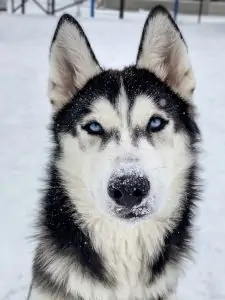
Siberian Huskies and Pitbulls come from very different backgrounds, but in many ways they have similar needs.
Today, crossbreed dogs like the Pitsky are some of the most popular canine companions. They are often seen as a combination of the best of two doggy worlds, which is great for dog lovers looking for variety.
However, there are some controversies that come along with crossbreeding, especially when you consider that newer generation hybrid dogs like the Pitsky are somewhat unpredictable.
The history of crossbreeding began centuries ago, but it was generally done by breed enthusiasts and experts working to create specific types of dogs for working and companionship purposes.
It takes generations of careful breeding before a crossbreed dog can finally be considered an official breed, and until then many of a crossbreed dog’s traits are left up to chance and genetics.
These characteristics include important traits such as health, temperament and physical appearance.
This is especially true for newer generation hybrids like the Pitsky mix, who could be more like a Pitbull over a Husky, or more like a Husky over a Pitbull, or he could be a perfect mix between his two parents.
The best way to really understand what you’re getting into when you’re committing to a crossbreed dog like the Pitsky is to take a closer look at both of the hybrid’s purebred parent breeds.
The Siberian Husky
As his name suggests, the Siberian Husky is a Spitz type of dog hailing from Siberia. Very people-oriented, Huskies were bred to live right alongside their families as they once did, originally protecting and coexisting with the nomadic Chukchi people.
These dogs were bred as sled pulling dogs, but they also served as guardians, protectors and beloved companions.
Today, Huskies are known for their stunning coats and outgoing dispositions. They are energetic, playful companions who do well in homes with active owners and large yards where they can run and play freely.
Huskies need quite a bit of routine exercise and maintenance throughout the day, and they’re not the ideal dogs for more laid back people or novice dog owners. They may also be overwhelming for very small children, though they can get along well with other dogs and older kids quite nicely when properly trained and socialized.
The American Pitbull Terrier
The American Pitbull Terrier is one of the only Pitbull types recognized officially by the American Kennel Club.
Like most Pitbulls, the American Pitbull Terrier was originally bred for bull baiting and dog fighting. It is believed these dogs are a combination of bulldogs and terrier types, designed specifically for their large jaws, muscular bodies and incredible devotion.
Sadly, this combination made them the ideal dog for blood sports, though these practices were officially outlawed in the United States in 1976.
Today, Pitbulls are rebuilding their reputations as family-friendly, affectionate and devoted dogs.
And, in spite of a negative past and stigma, Pitbulls have exploded in popularity and are considered intelligent, family friendly and affectionate dogs. They do best in homes with experienced and committed dog owners and, like their Husky counterpart, require routine exercise and mental stimulation each and every day.
So, what does this mean for the Pitbull Husky mix hybrid? Certainly that he’ll be high energy. But there’s so much more to know about this incredible mix.
Let’s begin with his temperament.
What Is The Temperament Of A Pitsky Dog?
Pitskies can make great family dogs when they are properly trained and socialized.
A cross between the high-energy Husky and the devoted Pitbull, the Pitsky is sure to be an enthusiastic and outgoing hybrid. This mix may seem to have endless amounts of energy, and he’ll make a great companion for homes with active children or outdoor enthusiasts.
However, for smaller children the Pitsky could be somewhat overwhelming. His playful nature may become exhausting for toddlers and those who are looking for a more relaxed, easy going dog.
With all of that being noted, when a Pitsky does have all his exercise needs met and he is kept mentally stimulated throughout the day, he’s more than just a playful pup. Highly intelligent and devoted, Pitsky dogs are certainly man’s best friend.
They are very people and family oriented and affectionate. This means they are not outdoor only dogs, and are happiest living right alongside their family and partaking in day to day activities.
Although Pitsky dogs are devoted, intelligent and affectionate, they can be stubborn from time to time. This is especially true if your Pitsky inherits more of his Pitbull parent breed’s temperament.
The good news is that if you work to build a strong bond with your Pitsky and understand what motivates him, you should be able to train him easily.
Training and socialization are imperative for a PItksky mix, as these dogs can tend to have guarding instincts. Pitsky dogs may also be wary of other dogs, especially if they are not raised with these dogs or if they are not socialized enough with dogs outside the home.
And although the Pitbull Husky mix does get along well with children and is quite affectionate and fun-loving, it’s very important to remember that it’s never wise to leave small children unsupervised with any dog.
Be sure to invest in the appropriate equipment like puppy playpens to help separate children and dogs when you can’t be watching, and be sure to work with age appropriate children on how to interact with the family dog appropriately and safely.
Teaching youngsters the basics of canine body language may not only help prevent a dog bite in the future, but it can ensure everyone in the home is getting along safely and happily. Understanding your dog better can even enhance the bond built between him and the entire family, and that is certainly a win-win!
How To Ensure Your Pitsky Is Properly Trained and Socialized
Training and socialization should begin for a Pitsky in puppyhood and continue on throughout his lifetime.
As we touched on briefly above, it’s very important that the Pitsky is well trained and socialized beginning at an early age, ideally in puppyhood. All dogs require routine socialization and training early, and this is especially true for large breed dogs with potential guarding instincts.
Pitbulls especially can be prone to dog on dog aggression, especially unneutered male Pitbulls. However, this does not mean that all Pitbulls and Pitbull mixes will have problems with other dogs, and many get along well with dogs both inside and outside of the home when properly trained and socialized.
So, how do you train and socialize a Pitsky Mix?
Start immediately! It’s never too early to begin training a dog, and you can and should begin training and socializing as early as you possibly can, ideally in puppyhood.
When it comes to training, keep in mind that the Pitsky is a very intelligent hybrid who has the ability to pick up quickly and learn tricks and cues in a snap.
However, just because he can does not mean he will. Pitsky dogs are very active and can become bored easily. If training isn’t kept short, fun and game-like, these dogs will quickly lose interest and become stubborn.
While this can be frustrating, remember to use only positive reinforcement techniques with your Pitsky when it comes to training. This includes the use of patience, treats and praise. Avoid aversive training like scolding or punishment, as this can cause your Pitsky to shut down and may even lead to fear-based aggression down the road.
Instead, use high value treats that capture and hold your Pitsky’s attention, and keep training feeling like a game. Most experts agree that training dogs in five minute increments works best, with lots of breaks and playtime in between.
When you are training using training treats, it’s important to stick with treats that are small, smelly and chewy. These treats are more likely to keep your dog’s focus.
Zuke’s Training Treats
No products found.
Some great training treats for a PItsky are going to be the above training treats by Zuke’s. These treats are made with natural, quality ingredients and come in different protein types depending on your dog’s unique sensitivities and needs.
We also like that these training treats are low in calories and small, making them perfect for rapid feeding training, leash training, and socialization as well.
And speaking of socialization, it’s important to begin socializing a Pitsky puppy early and to continue socializing him throughout his lifetime.
Socialization will include introducing him to as many new experiences as possible while at the same time working to ensure these experiences are positive for your dog.
Avoid forcing your Pitsky into situations that he is obviously frightened or wary of, and instead encourage him gently using your training treats and tons of praise.
While your Pitsky is a puppy, it’s also a good idea to introduce him to different people, other dogs, children and loud sounds. Get him used to having his ears, paws, nose and tail handled, and teach him basic cues like sit, stay, lay down, come, drop it and wait.
All of these cues can help when it comes to future training and socialization routines, and it can also set a solid foundation for your dog as he grows and learns from you.
Exercising and Mentally Stimulating Your Pitsky
Pitsky dogs are intelligent and active. Without proper mental and physical stimulation, they can become destructive.
One of the common themes of this article is that the Pitsky is a high energy breed that needs quite a bit of mental and physical stimulation.
As such, it’s probably no surprise that the Pitsky dog is not ideally suited for apartments or for owners who are unable to meet these unique and somewhat intensive exercise needs.
But just how much exercise does the Pitsky need?
Depending on your Pitbull Husky Mix, a Pitsky dog could need between an hour to two hours of committed exercise each and every day. This would include long walks, hikes, runs, or swims. On top of this, the Pitsky will also need free playtime in a securely fenced yard where he can run and explore.
Without proper physical exercise each and every day, your Pitsky could become depressed, anxious, bored and even destructive.
We suggest getting on a routine schedule with your Pitsky when it comes to exercise, which means you might consider giving him an hour walk once in the morning and once in the evenings, for example.
When you are walking your Pitsky, remember that this is a breed that could be prone to pulling. This is especially true if he inherits his Husky parent’s athleticism, as Huskies in particular were bred sled dogs.
Easy Walk Dog Harness
No products found.
Unfortunately, many people turn to choke chains or prong collars to stop dogs from pulling, but these types of equipment can actually be dangerous for your dog. Instead, we recommend using a no pull front clip harness like the above Easy Walk Dog Harness.
This type of no-pull dog harness helps reduce your Pitsky dog’s natural urge to pull by clipping in the front, alleviating the pressure on his chest and throat. If your Pitsky does pull ahead, the front clip will gently guild him back to you without harming him.
Not only does this make walking easier for you and your dog, it also makes it feel more natural for your Pitsky and may even help you to teach your dog better walking manners when used in conjunction with treats!
Along with routine exercise each and every day, it’s also imperative that the Pitsky is kept mentally stimulated.
Remember, this hybrid dog is quite intelligent and he comes from two parent dogs bred for specific working purposes. If his mind is not kept active and engaged, he can become destructive and anxious.
To prevent destructive behaviors, we recommend investing in puzzle toys and KONGS, as well as considering crate training your Pitsky to help reduce anxious behaviors while you are away.
When done properly, crate training can help reduce a number of problematic behaviors brought on by anxiety while also ensuring your dog feels safe, relaxed and happy waiting for you to come home.
Grooming Requirements and Basic Care For A Pitsky
Pitsky dogs are shedding dogs and require routine brushing and care.
If you’re considering a Pitsky but you have allergies, you may be in luck. While these dogs are shedding dogs, they generally shed less than Huskies and often have shorter, smoother coats like Pitbulls.
Of course, some Pitsky dogs do have longer fur and can shed heavier like their Husky parent breed, so this is something to keep in the back of your mind.
Either way, the Pitsky is going to need routine brushing at least once a week with a deshedding comb or slicker brush. This will help reduce loose hair and remove dirt, debris and dander than has built up from your dog being outside.
Pitsky dogs are relatively clean, and they don’t require baths too often. In fact, overbathing your Pitsky can exasperate skin issues and allergies, which these dogs are already predisposed to.
We recommend bathing your Pitsky once every four to six weeks using a dog-safe shampoo that is free of dyes, additives, parabens, or alcohols that could strip your Pitsky’s coat of the natural oils it produces that help to keep it healthy.
Burt’s Bees Hypoallergenic Dog Shampoo
No products found.
Because Pitsky’s can be sensitive to a number of ingredients in shampoos, we recommend investing in a hypoallergenic dog shampoo that uses natural ingredients to help soothe your dog’s skin and nourish his coat.
The above shampoo by Burt’s Bees for Dogs is specifically designed for dogs with skin sensitivities and not only helps reduce odor and remove buildup of dirt and debris, but it leaves your dog smelling, looking and feeling his best.
Outside of bathing and brushing, your Pitsky should have his ears routinely checked and cleaned to keep them free of waxy buildup, debris and moisture that could lead to ear infections.
His nails should be trimmed or ground down routinely using canine nail clippers or a nail grinder, and his teeth should be brushed at least once a day using a dog safe tooth brushing kit or doggy dental wipes.
Pitsky Health issues and Lifespan
The Pitbull Husky mix is a healthy dog overall, but he can be prone to some serious genetic health issues you should be aware of.
Both the Pitbull and the Husky are hardy breeds, though that doesn’t mean they are free of genetic health issues.
Like all dogs, the Pitbull and Husky can be prone to a number of genetic health issues that they can pass on to their hybrid offspring.
And while crossbreed dogs like the Pitsky are often considered healthier than their purebred parent breeds thanks to hybrid vigor, it’s important to note that they can still be predisposed to any and all of the same issues.
The good news is that the Pitsky is a relatively heathly and long-lived crossbreed, with a lifespan of between 12 and 15 years.
The most common health issues you may see in a Pitsky include:
- Hip Dysplasia
- Elbow Dysplasia
- Skin Issues
- Allergies
- Thyroid Problems
- Congenital Heart Defects
- Degenerative Myelopathy
- Kneecap Dislocation
- Gastric Dilation-Volvulus (AKA Bloat or GDV)
- Cataracts
- Progressive Retinal Atrophy
- Follicular Dysplasia
- Zinc Deficiency
- Hypothyroidism
- Corneal Dystrophy
- And Uveodermatologic Syndrome
Because the Pitsky is a crossbreed, it can be difficult to determine exactly what genetic health issues he may be more predisposed to. If you get your Pitsky from a breeder, you will likely also receive a certificate of health proving your puppy has been screened and cleared of any serious health issues.
However, you also have the option of having your Pitsky health screened early on using a canine DNA kit.
These kits can provide you with an abundance of information about your dog’s genetic history, including his health.
Outside of health testing, you can also help combat particular health issues by following the below tips from experts:
Get Your Pitsky from A Reputable Source
Avoid going through irresponsible breeders or online sellers, and instead stick with a certified breeder or shelter you trust.
Ensuring your dog has been responsibly bred and cared for before he comes to you helps reduce potential behavioral and health risks down the road.
Keep Up With Routine Vet Exams
Like people, dogs should be seen annually for checkups. In fact, many veterinarians recommend that dogs be seen at least once a year until the age of seven, and then twice a year after the age of seven.
Consider Investing In Pet Health Insurance
Vet visits can get expensive, but pet health insurance can help take the edge off pricy vet bills and help ensure your dog is healthy and happy throughout his lifetime.
Keep Your Pitsky on A Healthy Diet
The Pitsky can be prone to a number of health issues that can be diet related, including Bloat and allergies.
A quality dog food specified for your dog’s age, weight and activity level can help reduce certain health issues. For the Pitsky, we recommend a high quality dog food made with real animal protein like beef, lamb or fish. Avoid poultry, as this could exacerbate allergies in your dog.
Also look for a dog food that contains a good source of water, has fatty acids, carbs, vitamins, minerals and nutrients your dog needs to thrive.
Along with good dog food, you might also consider investing in a puzzle feeder. Also known as slow feeders, puzzle feeders can help reduce Bloat in your dog by ensuring he slows down when he eats and therefore reducing the amount of air swallowed during mealtime.
Maintain A Good Exercise and Grooming Routine
Last but not least, be sure you keep up with proper grooming and exercise routines. Ensuring your dog is looking his best will help him to feel his best inside and out.
Are You The Ideal Owner For A Pitsky Dog?
Pitbull Husky mix dogs are great companions, but they’re not right for every owner or family.
Pitsky dogs are great companions for the right family or owner, but they are not ideal for everyone. Remember, they can be overwhelming to families with very small children, novice dog owners, or dog owners who are more laid back and relaxed.
The ideal owner for a Pitsky hybrid is going to be an active owner or family that enjoys being outdoors and has a flexible schedule so they can bring their Pitsky with them often on adventures.
Pitsky dogs are not ideal apartment dogs and instead thrive in homes with large, securely fenced yards or gardens where they can run and play freely. They get along well with older children and other pets, but it’s very important that they are properly raised, trained and socialized at an early age and then consistently throughout their lifetime.
How Much Is A Pitsky Puppy Or Rescue Dog?
The Husky Pitbull Mix can be found through breeders or you can even adopt!
If you have your heart set on a Pitsky puppy through a breeder, you’re in luck. These dogs are increasing in popularity and shouldn’t be too difficult to find. On average, a Pitsky puppy costs between $500 and $2,000 depending on the breeder and the quality of your Pitsky puppy’s parents.
Of course, you also have the option of rescuing. Adopting a Pitsy through a shelter or rescue is not only rewarding, but it also provides a home for a dog in need. Sadly, dogs like Pitbulls and Huskies, and subsequently their Pitsky offspring, are some of the most common types of dogs turned over to shelters by overwhelmed owners.
Adopting a Pitsky has many benefits, and one of those is price. It is often a fraction of the cost to adopt a dog through a shetler when compared to the cost of buying through a breeder. Furthermore, you may be able to find a Pitsky dog that has undergone some basic training and behavioral testing. If you get an adult Pitsky, you’ll be able to better determine your dog’s coat type and appearance. Some adult Pitsky’s that are up for adoption may have also already been spayed or neutered, or even microchipped!
So, what do you think about the Pitsky hybrid? Is this the dog you’ve been dreaming of? Share your thoughts with us about the Pitbull Husky Mix in the comment section below.
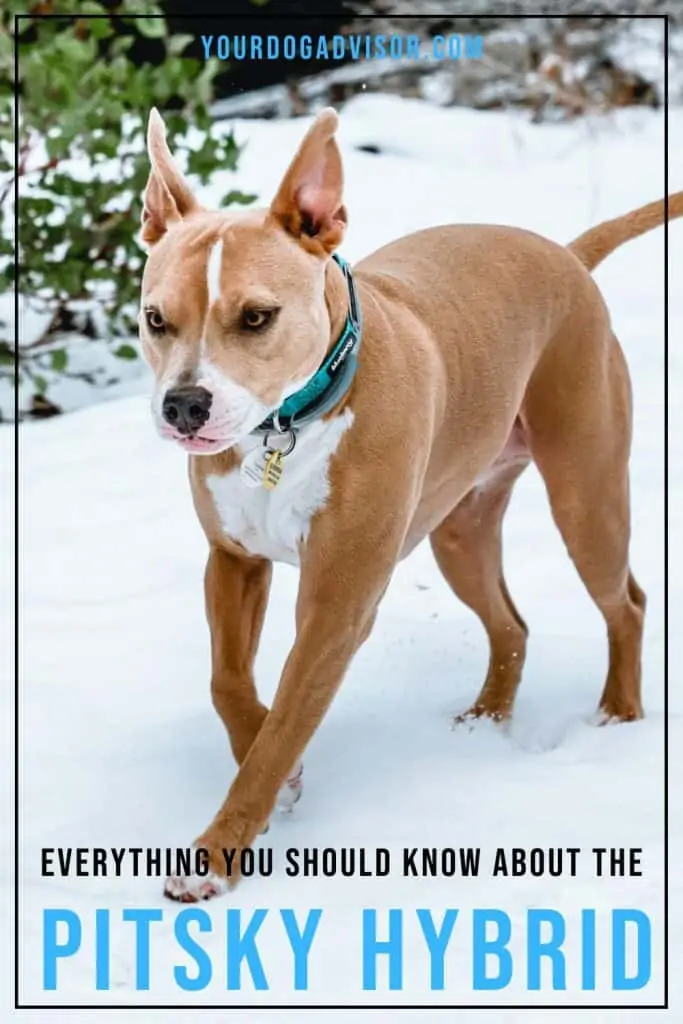

Jen Jones is a professional dog trainer and behavior specialist with more than 25 years of experience. As the founder of ‘Your Dog Advisor’ and the ‘Canine Connection’ rehabilitation center, she applies a holistic, empathetic approach, aiming to address root causes rather than merely treating symptoms.
Well known for her intuitive and compassionate approach, Jen adopts scientifically-proven, reward-based methods, encouraging positive reinforcement over punishment. Jen specializes in obedience training, behavior modification, and puppy socialization. Her innovative methods, particularly in addressing anxiety and aggression issues, have been widely recognized. Jen has worked with many of the world’s leading dog behaviorists and in her free time volunteers with local animal shelters and rescue groups.
